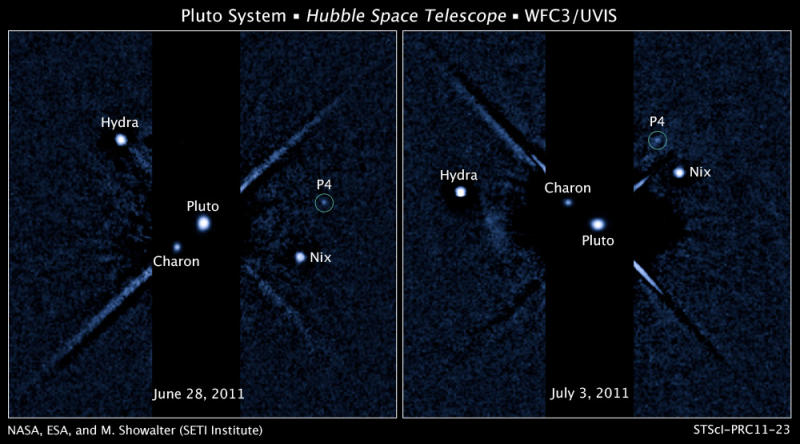Please note: Osher Rainforest will be closed for maintenance May 7-9.
Science News
Pluto's New Moon
July 22, 2011

If you didn’t hear the big news this week, Pluto, everybody’s favorite dwarf planet, has a new moon. Not new to Pluto, actually, but new to us.
The new moon was discovered by the Hubble Space Telescope last month and has been given an imaginative name—P4 (it’s the fourth moon discovered around the Kuiper Belt object). National Geographic News reports:
But this moniker is "just a license plate to refer to it until we get a name, and we're working on that, but we don't yet have a proposal to make," said Alan Stern, principal investigator of NASA's Pluto-bound New Horizons spacecraft and a member of the P4 discovery team.
(Want to make a suggestion? New Scientist has a blog devoted to the moon’s new name, and it seems the scientists are paying attention!)
It’s small—its estimated diameter is 8 to 21 miles. By comparison, Charon, Pluto's largest moon, is 648 miles across, and the other moons, Nix and Hydra, are in the range of 20 to 70 miles in diameter.
"I find it remarkable that Hubble's cameras enabled us to see such a tiny object so clearly from a distance of more than 3 billion miles," says Mark Showalter of the SETI Institute, who led this observing program with Hubble.
The finding is a result of ongoing work to support NASA's New Horizons mission, scheduled to fly through the Pluto system in 2015. The mission is designed to provide new insights about worlds at the edge of our solar system. Hubble's mapping of Pluto's surface and discovery of its satellites have been invaluable to planning for New Horizons' close encounter.
"This is a fantastic discovery," says Stern. "Now that we know there's another moon in the Pluto system, we can plan close-up observations of it during our flyby."
The dwarf planet's entire moon system is believed to have formed by a collision between Pluto and another planet-sized body early in the history of the solar system. The smashup flung material that coalesced into the family of satellites observed around Pluto.
Lunar rocks returned to Earth from the Apollo missions led to the theory that our moon was the result of a similar collision between Earth and a Mars-sized body 4.4 billion years ago. Scientists believe material blasted off Pluto's moons by micrometeoroid impacts may form rings around the dwarf planet, but the Hubble photographs have not detected any so far.
P4 was first seen in a photo taken with Hubble's Wide Field Camera 3 on June 28. It was confirmed in subsequent Hubble pictures taken on July 3 and July 18. The moon was not seen in earlier Hubble images because the exposure times were shorter. There is a chance it appeared as a very faint smudge in 2006 images, but was overlooked because it was obscured.
To read more about moons and Pluto, check out this recent article by Pluto-killer (and Academy fellow) Mike Brown.
Image: ASA, ESA, and M. Showalter (SETI Institute)